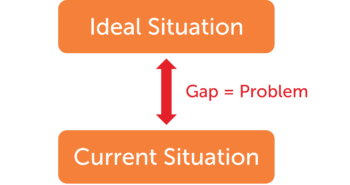The team need to look at the current situation in the city. What is the current bicycle theft rate in the city? Using law enforcement figures alongside estimated bicycle theft reporting estimates, it’s calculated that a bicycle theft happens in the city approximately once per hour (24 per day), which is 25% higher than the average of 3 other neighbouring cities.
Now the current situation is understood, they can set a goal for the ideal situation for the city. Given some budget and resource constraints, the team agree with a citizen panel that the ‘ideal’ would be to reduce the thefts by at least 30%, to approximately 16 a day.
With the current and ‘ideal’ situations outlined, the team have now identified this 30% gap in the theft rate versus the current situation. Now they can present the correct problem:
How can we reduce bicycle theft by 30% in our city?
With the correct problem identified, the team can now follow the next steps to analyze the root cause of the problem and then develop the right countermeasures or solutions to best reduce bicycle theft.
Once they have analyzed the root cause of the problem, perhaps online marketplace monitoring will be the correct solution, but maybe not. Maybe they will find any number of other approaches that might suit the city better (bike registration, secure bicycle stores, CCTV etc.). The right process will help lead them to the best countermeasure.
It can be tempting to jump straight to ‘solution sets’ in order to solve the problem quickly. If we don’t take time to properly analyze the problem, we might not arrive at the best solutions.
In the Sustainable Cities Challenge, we’re currently looking for cities to enter with a problem or challenge they’re looking to address.
How can cities apply this framework when entering the Sustainable Cities Challenge?
When you fill out the entry form and answer the questions regarding the specific problem or challenge that you’d like to address, you can apply the simple approach outlined above – share data about the current situation in your city related to the theme that you select. Then highlight the evidence you have and the goals you have to describe the ‘ideal’ situation in your city. This will help surface the existing gap. Then, through the Challenge together can identify innovative solutions that could help to close the gap between the current and ideal situation.
In the Challenge, we are looking for a problem that is not currently being addressed by existing processes, and you may not know where the best solution could come from. It’s in situations like this where open innovation challenges can be most impactful, identifying and supporting innovative solutions that will can have a tangible impact.





